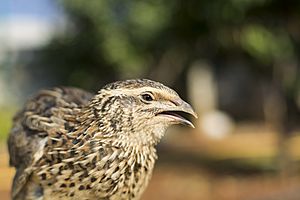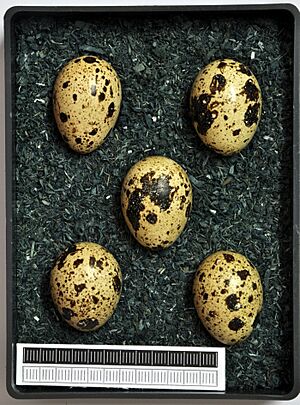Common quail facts for kids
Quick facts for kids Common quail |
|
|---|---|
 |
|
| Conservation status | |
| Scientific classification | |
| Genus: |
Coturnix
|
| Species: |
coturnix
|
 |
|
| Range of C. coturnix Breeding Resident Non-breeding Possible extinct & Introduced Extant & Introduced (resident) | |
| Synonyms | |
|
|
The common quail (Coturnix coturnix), also called the European quail, is a small bird. It lives on the ground and belongs to the pheasant family. These birds are mostly migratory, meaning they travel long distances. They breed in parts of Europe and Asia and spend winter in Africa and southern India.
You'll often hear this quail before you see it. It makes a special call that sounds like three quick chirps repeated over and over. Common quails are found across Europe and North Africa. Scientists say they are "least concern," meaning there are plenty of them.
Don't confuse the common quail with the Japanese quail. The Japanese quail looks similar but has a very different call. Both types of quails are sometimes raised as poultry for food.
Contents
Understanding Quail Families: Taxonomy
Scientists use a system called taxonomy to name and group living things. This helps us understand how different animals are related. The common quail was first officially described by a Swedish naturalist named Carl Linnaeus in 1758. He gave it the scientific name Tetrao coturnix. The word coturnix is Latin for common quail.
Later, the common quail was placed in the genus Coturnix. For a while, people thought the common quail and the Japanese quail were the same species. But now we know they are different. Even though they live in some of the same areas, they don't usually breed together. If they do, their offspring are not very fertile.
There are five different types, or subspecies, of the common quail:
- C. c. coturnix (Linnaeus, 1758) – Breeds in Europe and northwest Africa to Mongolia and north India. Winters in Africa and central and south India.
- C. c. conturbans Hartert, 1917 – Found in the Azores islands.
- C. c. inopinata Hartert, 1917 – Lives in the Cape Verde Islands.
- C. c. africana Temminck & Schlegel, 1848 – Found in sub-Saharan Africa and islands like Mauritius, Comoros, and Madagascar.
- C. c. erlangeri Zedlitz, 1912 – Lives in east and northeast Africa.
What Does a Common Quail Look Like?
The common quail is a small, compact bird. It is about 16 to 18 centimeters (6 to 7 inches) long. Its wingspan, which is how wide it is with its wings spread, is about 32 to 35 centimeters (12 to 14 inches). These birds usually weigh between 70 and 140 grams (2.5 to 5 ounces). They are heaviest right before they migrate. Female quails are usually a little heavier than males.
Common quails have brown feathers with streaks. They have a white stripe above their eye. Male quails also have a white chin. Unlike many other game birds, common quails have long wings. This helps them fly long distances when they migrate.
Where Do Quails Live and What Do They Eat?
Common quails are ground birds. They spend their time on the ground looking for food like seeds and insects. They are very good at hiding in tall crops and plants. They don't like to fly and prefer to sneak away instead. Even if you scare one, it will fly low to the ground and quickly hide again.
Often, the only way you know a common quail is nearby is by hearing the male's distinct "wet-my-lips" song. They usually sing in the mornings, evenings, and sometimes at night. Unlike most game birds, common quails are strong migratory birds.
Common quails were brought to the island of Mauritius several times. However, they never managed to settle there and are now likely gone from the island.
Quail Life: Breeding and Habits
How Common Quails Raise Their Young
Male quails usually arrive at the breeding areas before the females. In northern Europe, females start laying eggs around mid-May. They can continue laying until late August if they have more than one clutch.
The female makes a shallow dip in the ground, about 7 to 13.5 centimeters (3 to 5 inches) wide. She lines it with a few bits of plants. She lays one egg every 24 hours until she has a clutch of 8 to 13 eggs. The eggs are off-white or creamy yellow with dark brown spots. Each egg is about 30 x 23 millimeters (1.2 x 0.9 inches) and weighs about 8 grams.
The female sits on the eggs by herself after all of them are laid. The eggs hatch at the same time after 17 to 20 days. The young chicks are able to move around and feed themselves soon after hatching. The mother quail takes care of them and keeps them warm when they are small. The young birds can fly when they are about 19 days old. They stay with their family for 30 to 50 days. Most common quails start breeding when they are one year old and usually have only one group of chicks per year.
Quails and People
Common quails are hunted as game birds, especially as they fly through the Mediterranean area. Many birds are caught in nets along the coast of Egypt. In 2012, it was estimated that millions of quails were caught during their autumn migration in Egypt.
In recent years, more people in the United States and Europe have started raising common quails. However, most of this is done by hobbyists who enjoy keeping them. In some places, like Ireland, the number of wild common quails is going down.
The Bible, in the Book of Numbers chapter 11, tells a story about a huge number of quails. A strong wind blew them into the wilderness, and the Israelites gathered them for food.
In 1537, Queen Jane Seymour, who was King Henry VIII's third wife, was pregnant. She really wanted to eat quail. So, people working for the king and diplomats in other countries were told to find enough quails for the Queen.
Can Quail Meat Make You Sick?
Sometimes, if common quails have eaten certain plants, their meat can make people sick. Scientists are still debating which plants cause this. About one in four people who eat this meat can get an illness called coturnism. This illness causes muscle soreness and can sometimes lead to serious problems.
Gallery
See also
 In Spanish: Codorniz común para niños
In Spanish: Codorniz común para niños







